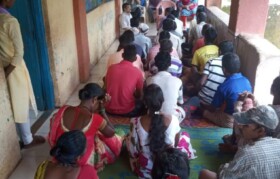Eye Check up and Meeting for Primary Health Center

This post has already been read 1054 times!
Initially, we tried various options for eye checkup. Earlier, we used to take a combination of ophthalmologist and optometrist to the schools. This model was ok, if we had to check around 60 to 70 in a day. However, when we had to cover 500 odd kids, it was impossible to even complete the basic optometry (Checking the basic vision against the chart). Most of the first standard kids did not have familiarity with the letters. Quite a few of them were not able to understand the instructions of the optometrist, which resulted in erroneous recording of results or delays in the completing the steps. We introduced new model in the academic year of 2014-15. We handed over the vision chart to the teachers, wherein the kids had to stand from 20 feet and read the lines from each eye. Ideally, they were expected to read up to 7th line. However, if they are not able to go beyond 5th line by either or both the eyes, then we mark them for the next round of investigation. We generally find 5 to 5.5% suspect cases in the initial screening. For example, we had 25 cases, identified for the next round, after the initial screening. Generally, 10% of identified cases don’t have any problems. Sixty to seventy percent kids have normal glasses wherein the number is less than -1. However, we identify at least 20% cases, wherein the myopia is severe or some other disease such nystagmus, high squint .. We found a case wherein the kid developed traumatic cataract, which made his vision almost zero with that eye. These cases are referred to Dr Mihir Kothari at Thane.
We completed the second round of screening on 28th Sept at Vikramgad. A good refractometer helps a lot to get accurate results. We had 26 kids this time for the tests. Except for 3 or 4, rest all would be given spectacles. Seven kids would be visiting Thane on 1st Oct, 2019 for the advanced checkup.
We have been planning to have our health center in Vikramgad area. The villagers don’t have access to even the basic medical support and they have to travel to at least 10 to 12 kms to avail the same. With the addition of medical experts in our group, we decided to explore the possibility of starting one at Kaspada. We paid a visit on 28th Sept, interacted with the villagers, understood their problems, got their buy in for this initiative and identified a place for the basic health care facility. It would still be in the experimental phase to start with. If we are able to have our own school, then the medical facilities would be hosted at the school premises and the individual villages would be serviced with the help of mobile van.
We spent some time in identifying the place, where we can have our own school in the near future. We have been able to support government aided primary schools so far. However, once the kids move out of the schools, they don’t have good facilities for the quality education. We would be sharing more information in this context in next few months.
Picture Gallery







